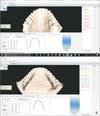1. Fujita K. New orthodontic treatment with lingual bracket mushroom arch wire appliance. Am J Orthod. 1979; 76:657–675.

2. Kurz C, Swartz ML, Andreiko C. Lingual orthodontics: a status report. Part 2: Research and development. J Clin Orthod. 1982; 16:735–740.
3. Takemoto K, Scuzzo G, Lombardo LU, Takemoto YU. Lingual straight wire method. Int Orthod. 2009; 7:335–353.
4. Shpack N, Geron S, Floris I, Davidovitch M, Brosh T, Vardimon AD. Bracket placement in lingual vs labial systems and direct vs indirect bonding. Angle Orthod. 2007; 77:509–517.

5. Balut N, Klapper L, Sandrik J, Bowman D. Variations in bracket placement in the preadjusted orthodontic appliance. Am J Orthod Dentofacial Orthop. 1992; 102:62–67.

6. Geron S. The lingual bracket jig. J Clin Orthod. 1999; 33:457–463.
7. Stamm T, Wiechmann D, Heinecken A, Ehmer U. Relation between second and third order problems in lingual orthodontic treatment. J Ling Orthod. 2000; 1:5.
8. Geron S, Romano R, Brosh T. Vertical forces in labial and lingual orthodontics applied on maxillary incisors--a theoretical approach. Angle Orthod. 2004; 74:195–201.
9. Liang W, Rong Q, Lin J, Xu B. Torque control of the maxillary incisors in lingual and labial orthodontics: a 3-dimensional finite element analysis. Am J Orthod Dentofacial Orthop. 2009; 135:316–322.

10. Park KH, Bayome M, Park JH, Lee JW, Baek SH, Kook YA. New classification of lingual arch form in normal occlusion using three dimensional virtual models. Korean J Orthod. 2015; 45:74–81.

11. Wiechmann D, Rummel V, Thalheim A, Simon JS, Wiechmann L. Customized brackets and archwires for lingual orthodontic treatment. Am J Orthod Dentofacial Orthop. 2003; 124:593–599.

12. Takemoto K, Scuzzo G. The straight-wire concept in lingual orthodontics. J Clin Orthod. 2001; 35:46–52.
13. Nouri M, Asefi S, Akbarzadeh Baghban A, Ahmadvand M, Shamsa M. Objective vs subjective analyses of arch form and preformed archwire selection. Am J Orthod Dentofacial Orthop. 2016; 149:543–554.

14. Padisar P, Nouri M, Zajkani E. Changes in mandibular anterior teeth alignment of 12–14 years olds during a 4-years follow up in Qazvin. Iranian J Orthod. 2008; 3:109–115.
15. Nouri M, Farzan A, Safavi MR, Akbarzadeh Bagheban A. Evaluation of number of reference clinical points effect on dental arch curve construction with three-dimensional method. J Indian Dent Assoc. 2012; 24:104–110.
16. Nouri M, Massudi R, Bagheban AA, Azimi S, Fereidooni F. The accuracy of a 3-D laser scanner for crown width measurements. Aust Orthod J. 2009; 25:41–47.
17. Thurow RC. Edgewise orthodontics. 4th ed. St. Louis: Mosby;1982. p. 327.
18. Archambault A, Major TW, Carey JP, Heo G, Badawi H, Major PW. A comparison of torque expression between stainless steel, titanium molybdenum alloy, and copper nickel titanium wires in metallic self-ligating brackets. Angle Orthod. 2010; 80:884–889.

19. Morina E, Eliades T, Pandis N, Jäger A, Bourauel C. Torque expression of self-ligating brackets compared with conventional metallic, ceramic, and plastic brackets. Eur J Orthod. 2008; 30:233–238.

20. Sifakakis I, Pandis N, Makou M, Eliades T, Katsaros C, Bourauel C. A comparative assessment of torque generated by lingual and conventional brackets. Eur J Orthod. 2013; 35:375–380.

21. Manni A, Cirulli N, Grassi R. Personalized orthodontic bracket height in relation to marginal ridges. World J Orthod. 2007; 8:e10–e14.
22. Scuzzo G, Takemoto K, Takemoto Y, Takemoto A, Lombardo L. A new lingual straight-wire technique. J Clin Orthod. 2010; 44:114–123. quiz 106.
23. Fillion D. Clinical advantages of the Orapix-straight wire lingual technique. Int Orthod. 2010; 8:125–151.

24. Fillion D. Lingual straightwire treatment with the Orapix system. J Clin Orthod. 2011; 45:488–497. quiz 515.
25. Lombardo L, Saba L, Scuzzo G, Takemoto K, Oteo L, Palma JC, et al. A new concept of anatomic lingual arch form. Am J Orthod Dentofacial Orthop. 2010; 138:260.e1–260.e13. discussion 260–1.

26. Oda S, Arai K, Nakahara R. Commercially available archwire forms compared with normal dental arch forms in a Japanese population. Am J Orthod Dentofacial Orthop. 2010; 137:520–527.

27. Kairalla SA, Scuzzo G, Triviño T, Velasco L, Lombardo L, Paranhos LR. Determining shapes and dimensions of dental arches for the use of straight-wire arches in lingual technique. Dental Press J Orthod. 2014; 19:116–122.

28. Felton JM, Sinclair PM, Jones DL, Alexander RG. A computerized analysis of the shape and stability of mandibular arch form. Am J Orthod Dentofacial Orthop. 1987; 92:478–483.

29. AlHarbi S, Alkofide EA, AlMadi A. Mathematical analyses of dental arch curvature in normal occlusion. Angle Orthod. 2008; 78:281–287.

30. Noroozi H, Nik TH, Saeeda R. The dental arch form revisited. Angle Orthod. 2001; 71:386–389.
 ) is the quadratic mean of the absolute values, which in this case is the total distance of the 14 teeth to the polynomial curve. A smaller RMS shows that the polynomial curve, which represents the lingual straight wire, is better adapted to the bracket points.
) is the quadratic mean of the absolute values, which in this case is the total distance of the 14 teeth to the polynomial curve. A smaller RMS shows that the polynomial curve, which represents the lingual straight wire, is better adapted to the bracket points.



 PDF
PDF ePub
ePub Citation
Citation Print
Print








 XML Download
XML Download